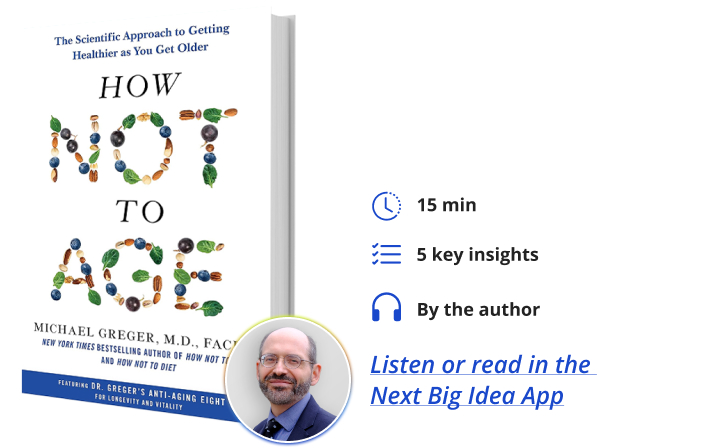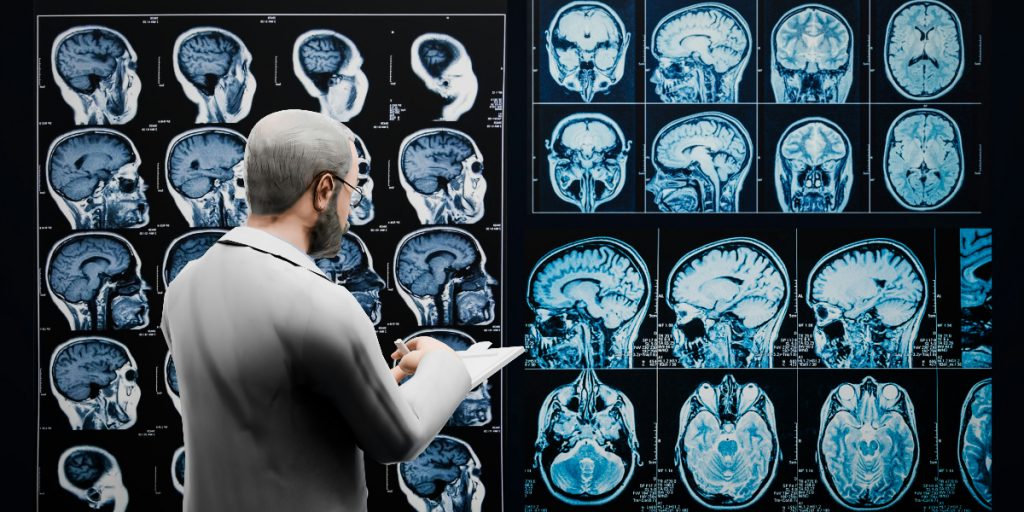Michael Greger, MD is a physician, New York Times bestselling author, and a founding member and Fellow of the American College of Lifestyle Medicine. He is also an internationally recognized speaker on nutrition, food safety, and public health issues. In 2017, Dr. Greger was honored with the ACLM Lifestyle Medicine Trailblazer Award. He is a graduate of Cornell University School of Agriculture and Tufts University School of Medicine.
Below, Michael shares five key insights from his new book, How Not to Age: The Scientific Approach to Getting Healthier as You Get Older. Listen to the audio version—read by Michael himself—in the Next Big Idea App.

1. We have tremendous power over our health destiny and longevity.
The vast majority of premature death and disability is preventable with a healthy enough diet and lifestyle. There was an editorial published in the leading anti-aging journal Rejuvenation Research entitled, “Finally, a regimen to extend human life expectancy.” Was it some exotic new stem cell treatment or gene therapy? No, it was a reference to a Harvard analysis in which more than 100,000 men and women were followed for decades, and just a few basic lifestyle behaviors appeared to translate into 12 to 14 years of extra lifespan for the average 50 year-old. Even at age 50, you may be able to add an extra dozen years to your lifespan. Even at age 70, there could still be about ten extra years on the table. And if you clean up your life before age 50, nearly 18 years may be up-for-grabs based on simple common-sense behaviors.
After decades of research, and hundreds of millions of dollars, efforts to translate life extension results from lab animal experiments and apply them to humans have largely been in vain. Yet here we are with human data suggesting dramatic life extension is available to all of us, right here, right now. We already have that trillion-dollar anti-aging pill that biotech has been promising us. It just has to be administered in the produce aisle and the gym. You can turn back the clock not with a drug or a DeLorean but just by eating and living more healthfully.
A midlife switch between the ages of 45 and 64 to even the barest of minimums: at least five daily servings of fruits and vegetables, walking 20 minutes a day, maintaining a healthy weight, and not smoking, can result in a substantial reduction in mortality, even in the immediate future. We’re talking a 40 percent lower risk of dying in the subsequent four years. The researchers conclude that making the necessary changes to adhere to a healthy lifestyle is extremely worthwhile, and middle-age is certainly not too late to act. You hold the power.
2. Follow the example of diets and lifestyles of the healthiest and longest-lived people around the world.
Studies following identical twins suggest that only about 25 percent of the variation in lifespan is explained by genetics. What can we do for the majority over which we may have some control? The media loves stories about hard-living centenarians who attribute their longevity to some combination of lard, vodka, and favorite brand of cigarette, but how do the oldest and healthiest really eat and live?
That’s what we have the Blue Zones for—areas of exceptional longevity around the world — where there may be ten times the rate of those reaching triple digits. (The Blue Zones are named for the color a demographer used in a global “heat map” of mortality.) What lessons can we learn?
“The foundation of the Blue Zones Food Guidelines is making your diet at least 95 percent plant-based.”
The Blue Zones organization distilled findings from more than 150 dietary surveys, from the world’s longest-living people to create a set of ten food guidelines. The foundation of the Blue Zones Food Guidelines is making your diet at least 95 percent plant-based, avoiding highly processed foods, and emphasizing beans as the healthiest source of protein, water as the best beverage, and nuts, as the healthiest snack. That’s the foundation. The final five guidelines are to go easy on fish, eliminate eggs, slash sugar, reduce dairy, and retreat from meat.
3. There may be no such thing as dying from old age.
From a study of more than 42,000 consecutive autopsies, centenarians—those who live to be a hundred— were found to have succumbed to disease in 100 percent of the cases. Though most were perceived, even by their physicians, to have been healthy just prior to death, not one, “died of old age.” They died from disease—most commonly, heart disease.
Because the single greatest risk factor for most of our killer diseases is how old you are, one could argue that the leading cause of death is actually aging. The rate of death increases exponentially for age-related diseases such as heart disease, cancer, stroke, and dementia. So yes, within the same age bracket, having high cholesterol can increase your risk of heart disease up to 20-fold, but an 80-year-old may have five hundred times the risk of having a heart attack compared to a 20-year-old. The reason we focus on things like cholesterol is because it’s a modifiable risk factor. But what if the rate of aging was modifiable too?
That is where a consensus document entitled “Interventions to Slow Aging in Humans” comes in. The top researchers in the field were brought together to identify the most promising strategies to combat aging. They identified a list of “essential pathways.” Examples are drugs, that can block the hormone IGF-1 or drugs that block the pro-aging enzyme TOR. In my research, I realized that every single one of these could be regulated through diet.
This may help explain why those eating plant-based diets—diets centered around whole healthy plant foods—have a lower risk of developing age-related diseases such as cancer and dementia, a lower risk of dying prematurely from cardiovascular disease and all causes put together, and also appear to age slower. Those who eat plant-based diets have been shown to have a substantially lower rate of aging. There’s an interventional trial that shows cause-and-effect by randomizing people to a plant-based diet and shows that eating healthier can indeed slow the pace at which you age.
“Replacing just three percent of daily caloric intake from animal protein with plant protein was associated with a 10 percent decreased risk of overall mortality.”
And it doesn’t take much. Plant-based doesn’t mean vegetarian or vegan. It just means the focus of the diet should be around whole plant foods. That means minimizing processed foods, meat, dairy, eggs, salt, and sugar while maximizing fruits, vegetables, whole grains, legumes—like beans, split peas, chickpeas, lentils, nuts and seeds, mushrooms, herbs, and spices. The real foods that grow out of the ground are our healthiest choices.
The NIH-AARP study is the largest forward-looking study on diet and health. Based on its six million persons and years of observation, replacing just three percent of daily caloric intake from animal protein with plant protein was associated with a 10 percent decreased risk of overall mortality. Just by swapping three percent!
In terms of lifespan, eating a burger appears to cut one’s life as short as smoking two cigarettes. So if it wouldn’t even occur to us to light up before and after lunch, maybe we should choose the bean burrito instead.
It isn’t just about adding years to your life, but life to your years. An unhealthy aging index was devised to measure functional impairments, vitality, mental health, and physical health. Substituting even just one percent of calories from plant protein for animal protein appeared to lead to significantly less deficit accumulation. Substituting five percent may reduce the risk of dying from the greatest deficit, dementia. That may help explain why those who don’t eat any meat at all may be up to three times less likely to become demented. But again, it’s not all-or-nothing.
4. The worst thing about humanity’s diet is neither animal nor vegetable but mineral: sodium.
According to the global burden of disease study—the most comprehensive study of risk factors for death and disability—the top five fatal flaws of humanity’s diet are inadequate vegetable consumption, inadequate nut and seed consumption, not eating enough fruit, and not getting enough whole grains. Millions of deaths may be attributable to each of those factors. But the single deadliest ingredient in humanity’s diet is something we get too much of: salt, our number one dietary risk factor for death.
A recent study, for example, found that those who salted their food at the table at age 50 appeared to have about a two-year lower life expectancy compared to those who didn’t. Swapping out the salt shaker for some salt-free seasoning or salt substitutes could potentially add years to your life.
“Cardiovascular disease death rates plummeted by 40 percent in the folks getting the reduced sodium blend.”
How do we know it’s cause and effect? Five kitchens at a veterans’ retirement home were randomized into two groups for a few years, offering meals salted either with regular salt or, unbeknownst to them, a 50/50 blend of regular salt, sodium chloride, with the potassium salt substitute, potassium chloride. The kind of salt was the only difference between the meals, and cardiovascular disease death rates plummeted by 40 percent in the folks getting the reduced sodium blend.
The new difference in life expectancy between the two groups at age 70 was equivalent to that which would have occurred naturally in 14 years. Simply switching to even half potassium salt—for which you wouldn’t even be able to taste the difference—appeared to effectively make people more than a decade younger when it came to the risk of premature death.
5. Specific foods are found to be helpful in clinical trials for age-related ailments.
In terms of your joints, studies have shown that strawberries, rose hips, ginger, and turmeric can help with osteoarthritis of the knees, the leading cause of disability in older adults. The herb saw palmetto fails to help enlarged prostates, but what has been shown to work is flaxseeds, pumpkin seeds, and cranberries. Cranberries can also help with overactive bladder syndrome. Pumpkin seeds, along with soy foods and chili peppers, may help protect against hair loss, and topically, diluted rosemary essential oil appears to work as well as the drug Rogaine for keeping your hair.
Soy foods and fennel seeds can help with menopausal hot flash symptoms. Fenugreek seeds can boost testosterone. Plain white button mushrooms help reduce the distinctive body odor of the elderly. Nitrate-rich vegetables like beets help maintain muscle mass and performance. Broccoli family vegetables and garlic can boost immune function. Greens and berries are probably the best foods for your brain and also help preserve your vision. Finally, though sun protection is the most important thing to slow skin aging, honeybush tea, almonds, and cocoa powder have also been shown to reduce wrinkles.
To listen to the audio version read by author Michael Greger, download the Next Big Idea App today:































